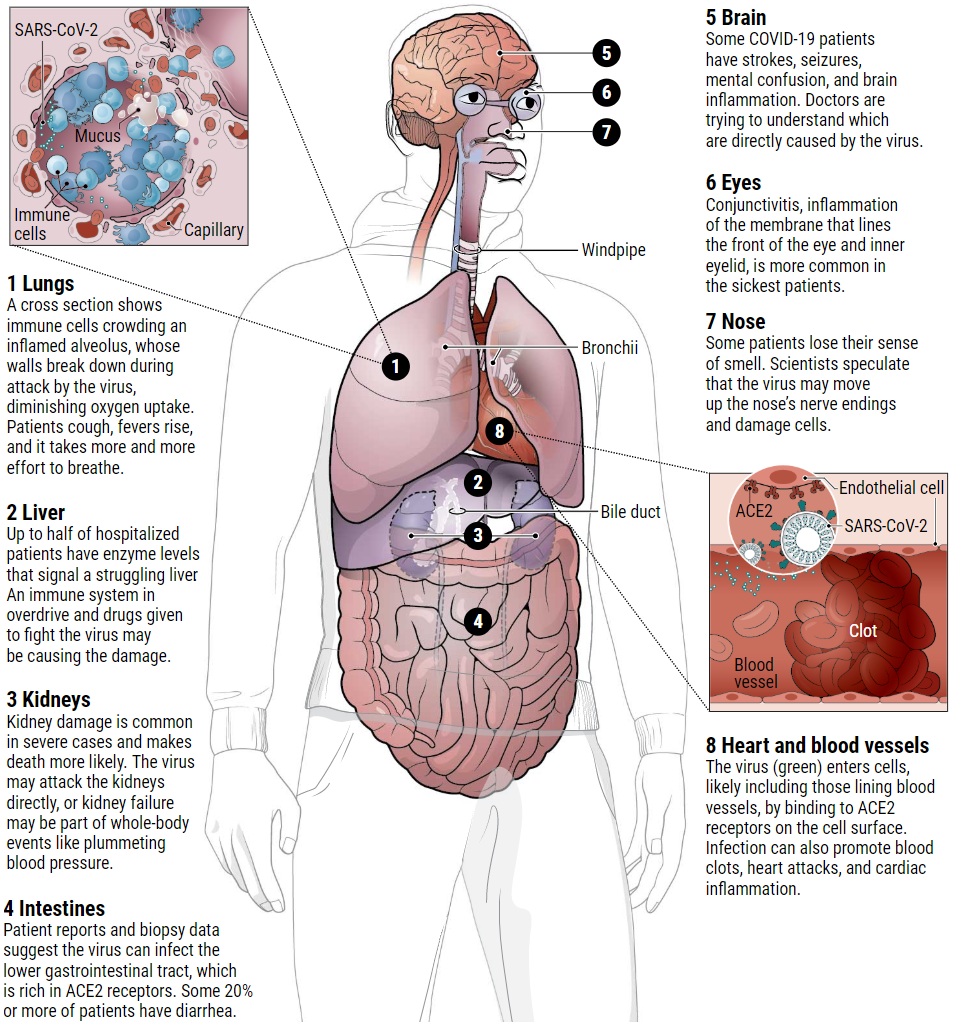每日外闻77
How does coronavirus kill? Clinicians trace a ferocious rampage through the body, from brain to toes
How does coronavirus kill? -4
Striking the heart-1
在意大利布雷西亚(Brescia),一名53岁的妇女走进当地医院的急诊室,出现了心脏病发作的所有典型症状,包括心电图出现明显的体征,血液中的一种血液标志物表明心肌受损。进一步的测试显示心脏肿胀和瘢痕,左心室(通常是心脏的动力室)非常虚弱,只能泵出正常数量血液的三分之一。但是,当医生在冠状动脉注射染料,寻找可能导致心脏病发作的阻塞物时,他们没有发现任何异常。另一项测试揭示了原因:这名女子感染了COVID-19。
病毒如何攻击心脏和血管是一个谜,但数十份预印文章和论文证明了这种损害是常见的。3月25日发表在《美国医学会杂志心脏病学》(JAMA Cardiology)上的一篇论文记录了中国武汉416例住院的covid19患者中近20%的患者出现了心脏损伤。在武汉的另一项研究中,138名住院患者中有44%患有心律失常。
这种破坏似乎延伸到了血液本身。根据4月10日发表在《血栓形成研究》(Thrombosis Research)杂志上的一篇论文,在一家荷兰重症监护病房的184名covid19患者中,38%的患者血液凝结异常,近三分之一的患者已经有了血栓。血凝块会破裂并进入肺部,堵塞重要的动脉,这种情况被称为肺栓塞。据报道,肺栓塞已导致19名患者死亡。动脉血栓也会进入大脑,导致中风。哥伦比亚大学医学中心心血管医学研究员贝努德•比克德利(Behnood Bikdeli)说,许多患者体内d -二聚体含量高得惊人,这是一种血凝块的副产品。
Bikdeli说:“我们观察得越多,就发现血凝块越可能是导致COVID-19疾病严重程度和死亡率的主要因素。”
感染也可能导致血管收缩。有报告显示,受感染者手指和脚趾出现了局部缺血——血液流动减少,可能导致肿胀、手或脚指疼痛和组织死亡。
Striking the heart-1
In Brescia, Italy, a 53-year-old woman walked into the emergency room of her local hospital with all the classic symptoms of a heart attack, including telltale signs in her electrocardiogram and high levels of a blood marker suggesting damaged cardiac muscles. Further tests showed cardiac swelling and scarring, and a left ventricle—normally the powerhouse chamber of the heart—so weak that it could only pump one-third its normal amount of blood. But when doctors injected dye in the coronary arteries, looking for the blockage that signifies a heart attack, they found none. Another test revealed why: The woman had COVID-19.
How the virus attacks the heart and blood vessels is a mystery, but dozens of preprints and papers attest that such damage is common. A 25 March paper in JAMA Cardiology documented heart damage in nearly 20% of patients out of 416 hospitalized for COVID-19 in Wuhan, China. In another Wuhan study, 44% of 138 hospitalized patients had arrhythmias.
The disruption seems to extend to the blood itself. Among 184 COVID-19 patients in a Dutch ICU, 38% had blood that clotted abnormally, and almost one-third already had clots, according to a 10 April paper in Thrombosis Research. Blood clots can break apart and land in the lungs, blocking vital arteries—a condition known as pulmonary embolism, which has reportedly killed COVID-19 patients. Clots from arteries can also lodge in the brain, causing stroke. Many patients have “dramatically” high levels of D-dimer, a byproduct of blood clots, says Behnood Bikdeli, a cardiovascular medicine fellow at Columbia University Medical Center.
“The more we look, the more likely it becomes that blood clots are a major player in the disease severity and mortality from COVID-19,” Bikdeli says.
Infection may also lead to blood vessel constriction. Reports are emerging of ischemia in the fingers and toes—a reduction in blood flow that can lead to swollen, painful digits and tissue death.
See you tomorrow



